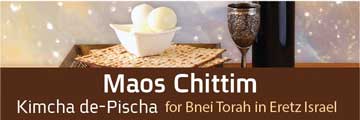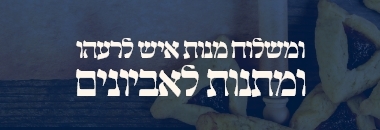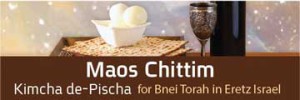This week’s article discusses the rabbinic halachos of separating meat from milk. Is placing a dairy item on a table on which meat is being eaten permitted? What about a bottle of baby formula — some parents check the temperature by tasting the bottle’s contents. Do they have to be particularly careful when placing the bottle on a meaty table? Would a person who suffers from milk allergies have a different halachic status because of his allergies?
Is it permitted for two people to eat at the same table if one is eating meat and the other – dairy? And what about two strangers sitting near a picnic table or on a park bench, one eating a deli sandwich and the other pizza — is there any prohibition involved? Why is the prohibition of mixing meat and dairy so severe? Can one cook dairy foods within six hours of eating meat? What about sitting at the table with friends eating cheesecake after eating a burger?
The Rabbinic Prohibitions of Meat and Milk
In this week’s parashah we are forbidden from mixing meat with milk: “You shall not cook a kid in its mother’s milk” (Shemos 23:19). In this week’s article we will focus on one of the rabbinic aspects of this prohibition – not eating meat and milk at the same table.
The Mishna (Chulin, 103b) records a rabbinic ordinance forbidding eating meat and dairy at the same table without one of the conditions that will be mentioned further on in this article.
According to Beis Hillel (Chulin 103b, 104b) these prohibitions also pertain to fowl, although the prohibition of mixing milk and fowl is rabbinic of nature. The Gemara asks (Chulin 104a) how could there be a rabbinic ordinance added to a rabbinic prohibition? The Gemara answers that without it, people would come to eat meat and dairy together. It remains, therefore, unclear if this is actually two facets of one ordinance or an outstanding occasion that requires adding prohibition to ordinance.
The Rishonim are divided in their understanding of this Gemara: Rashi explains that one who eats fowl on the same table with dairy will become accustomed to it, eventually eat beef and milk at the same table. However, the Rambam (Ma’achalos Asuros, chapter 9:20) learns that the concern is that one might come to eat fowl with dairy. Even though eating fowl with dairy is a rabbinic prohibition, in matters concerning mixing milk and meat Chazal were more stringent and added a prohibition to prevent the possibility of eating fowl with dairy. The Pri Chadash (Yore Deah chapter 88:1), Pri Megadim, and others explain that the Rambam’s reason is because both meat and milk are permitted foods and we are accustomed to eating them. Since there is no natural withdrawal from either of them, additional precautions are necessary to keep them separate.
The Taz and Pri Megadim (ibid) derive from the Shulchan Aruch, who follows the Rambam, that the prohibition of meat with milk is more severe than other Torah prohibitions. The Chochmas Adam (40:11), however, follows Rashi’s ruling, wondering at the Shulchan Aruch and the Taz’s rulings.
In light of this ruling, the Taz deduces (Yore Deah 98:5) that eating fowl with milk has the same severity as a Torah prohibition. Therefore, if milk spilled into a pot of chicken soup, for example, and we are unsure of the amount – less than 1/60 or more: if it is certainly less than 1/60th of the pot’s content, the soup is kosher because the milk does not add flavor to it. However, if it is more than 1/60th, it adds flavor to the soup and the soup is unkosher. Even if the amount of milk is unknown, the soup is still not kosher. The halacha would be the same if the pot contained meatballs. This contrasts with the general rule, that when the amount is unknown, if the prohibition in question is rabbinic, we rule leniently, following the rule that in case of uncertainty with a rabbinic prohibition we rule leniently. However, when it is a question of milk and meat, although fowl is a rabbinic prohibition, we nevertheless treat it like a Torah prohibition.
Setting a Table
The Mishna (Chulin 103b) writes: “The Sages issued a decree that it is prohibited to place any meat together with milk products, e.g., cheese, on one table.” and this is ruled by the Shulchan Aruch (Yore Deah 88:1). This prohibition pertains specifically to mealtime – one may not eat at a table on which meat and dairy items sit together. However, the action of setting such a table, or placing meat and dairy items on the same table contains no concern of tasting from either of them and is permitted.
This difference gives rise to a debate among the poskim how to judge various scenarios – are they considered setting a table, or eating at the same table.
Before mentioning these scenarios, some background is necessary. Various scenarios may be ruled as lo plug (i.e. no differentiation). In this case, the ruling must be upheld even though there is no concern of mistakenly transgressing the actual prohibition. It is permitted only where the poskim are convinced that there is an inherent difference between cases. Additionally, there are scenarios not included in the rabbinic ordinance, but which logically present the possibility of transgression. We must follow not only the letter of the law, but it’s spirit too, and when there is substantial concern that an action may cause transgression, one should take every precaution to prevent it.
Baby Formula on a Meaty Table
Can one place a baby bottle filled with formula or milk on the Shabbos table? It depends on one’s normal conduct. Some parents check the temperature or taste of the bottle by dripping the formula on their tongue, while others would never do such a thing. Obviously, one who is accustomed to testing the bottle on his tongue should refrain from placing it on the table while eating meat because he might accidently taste from the bottle (especially if the baby starts screaming and his parent might get upset and mixed up). However, one, for whom tasting the contents of a baby bottle is unthinkable, is permitted to place it on the table. For him, the liquid in the bottle is not a viable drinking option. This reasoning excludes this scenario from the rabbinic ordinance.
Contemporary poskim debate if it is permitted because the baby bottle is itself a clear distinction, or perhaps the ordinance must be upheld regardless, and every placing of milk on a meaty table requires an additional precaution (listed below).
The Pischei Teshuva (footnote 1) writes that leaving a candle fueled by butter on a meaty table is forbidden because at times the candle might drip. Since butter is kosher, one is not normally careful to prevent the dripping from touching food. Placing butter in a candle is not forbidden because butter in a candle is not intended for consumption. The only concern is that it may drip.
Rabbi Chayim Kaniyevsky (Harchakos V’Hazharos chapter 6: 26, 27), Rabbi Lieberman (Hama’or, issue 483 p. 26) and Vedorashta Vechokarta (volume 5, Yore Deah, chapter 3) permit one who never tastes liquids from a baby bottle to place it on a table while eating meat because they assume it is not considered a food item forbidden by Chazal. Rabbi Lieberman adds, though, that one should be careful when placing it on the table that the bottle’s content should not drip, just as the butter-candle is forbidden out of concern of possible dripping.
Uncooked Meat
A similar question is mentioned in the poskim: can uncooked meat be placed upon a table on which dairy is being eaten? The Atzei Haola is of the opinion that it is certainly permitted because the ordinance only pertains to food items ready for consumption. However, Badei Hashulchan (Yore Deah chapter 88) is uncertain if it is included in the rabbinic ordinance.
Milk Allergy
Suga Bashoshanim (Vind, chapter 4: 26) forbids even a person with milk allergies to eat meat on a table that also contains dairy even though he never tastes dairy since there is no differentiation in an isur d’rabonon.
Distanced Seating
Maharshal (quoted in Bach, Pri Megadim, and Pischei Teshuva, Yore Deah 88) rules that this ordinance is irrelevant if the food items are each placed at the opposite ends of a long table, for which reaching requires the effort of getting up. The rationale behind this is that until one gets up and reaches for the milk or meat, he will recall it is forbidden and stop himself. In his opinion, the ordinance was instituted to stop people who might reach out and eat something without thinking.
Sealed Containers
In light of the above-mentioned ruling, contemporary poskim debate regarding a sealed package – can a sealed package of deli meats sit on a table on which pizza is being eaten? Can a box of cheese be placed upon a table along with schnitzel sandwiches? Rav Ovadia Yosef (Yalkut Yosef, Kitzur Shulchan Aruch, Yore Deah, chapter 88:19), and Badei Hashulchan (Yore Deah chapter 88) forbid it.
Forbidding this would obviously only be when opening the container can be done easily. However, when opening the container is slightly difficult or requires special equipment (such as a can opener or scissors) the status is like that of a food item placed at the end of the table. This understanding of the halacha was mentioned by: Rabbi Luxemburg shlita, Rabbi Lieberman (Hama’or, issue 483 p. 26), and Vedorashta Vechokarta (volume 5, Yore Deah, chapter 3). Rabbi Lieberman, however, stresses that it is important to make sure the bag or container is clean on the outside and not dripping in a way that might bring it into contact with the foods on the table.
In the Waiting Period
Poskim are undecided if one who just finished eating meat may sit alongside a friend who is now eating dairy. The Beis Yaakov (Shut, chapter 12) and Ba’er Heitev (Yore Deah, chapter 88:2) forbid it. But the Kanfei Yona (Yore Deah, chapter 88) counters this ruling saying that additional distancing over that of the six hours between meat and milk is unnecessary. The Pri Megadim (chapter 88) adds that the only scenario mentioned in the Gemara is that of one who is handling the food, not one who is sitting near another person who is eating. The Chida (Shiurei Bracha, Yore Deah, chapter 88:8), Aruch Hashulchan (ibid, chapter 110), and Rav Ovadia Yosef (Yabia Omer, volume 6, chapter 8) all concur with this opinion.
The Pri Megadim’s ruling seems to indicate that the determining factor is touching or not touching the food, but the Yad Efraim (Yore Deah, chapter 88:2) differentiates between one who ate a full meal and is no longer hungry and one who just tasted a hotdog and may still be hungry. It would seem that after eating a full meal the accepted practice during the Yad Efraim’s lifetime was to not eat anything else. Today, however, with the ongoing nosh culture that sees people eating even after consuming a full meal perhaps this opinion would require reconsideration.
The Yad Efraim adds another leniency – if both know that one of them ate meat, sitting together could be permitted because his friend would stop him from tasting should he mistakenly try to taste dairy. Yad Efraim notes that cooking dairy is permissible even within the waiting time between meat and milk. He ends the discussion calling for every person to use his common sense — if one knows he may mistakenly taste from the cheesecake batter it is his obligation to proactively safeguard himself.
Rabbi Luxemburg shlita adds that, food preparation or sitting with friends during the six-hour waiting period between meat and dairy, is not included in the rabbinic ordinance. Therefore, if one is sure he will not come to eating from his friend’s food, or while cooking — not taste from it inadvertently, he is permitted to do so. However, one who might unintentionally taste the dairy should take all necessary precaution to prevent it.
Safeguarding
Rabbi Akiva Eiger (Hagahos, Yore Deah chapter 88:1) wrote that in this case, one should appoint someone to serve as a guard to remind him not to taste from the dairy. This is effective even if the guard is not sitting and eating along with them.
Eating together
When two people are eating at the same table, one eating meat and the other – dairy, the Shulchan Aruch (Yore Deah 88:2) rules that if they know each other, eating together is prohibited. But if they are strangers – it is permitted. The Shach (footnote 3) adds that the determining factor is if they are embarrassed to eat from each other. Only if they are friendly enough to taste from each other’s plates – it is forbidden.
If they wish to eat at the same table, a heker should be set up between them (Shulchan Aruch, ibid). This means that something not ordinarily on the table that is noticeable (e.g. a pen) should be placed between them as a reminder not to share food with one another. Alternatively, separate meat and dairy tablecloths or placemats can be used as a heker. The Knesset Hagedola (Yore Deah, chapter 88) and Chida (ibid, Shiurei Bracha, 6) write that even if initially both were eating pareve, and then one switched to eating meat while the other switched to eating dairy – no additional heker is necessary.
The Chochmas Adam (40:11) rules that a heker is sufficient also when one is eating alone and there are meaty items on a dairy table and vice versa. Rav Moshe Sternbuch (Teshuvaos V’Hanhagos, volume II, chapter 391) writes that even those who forbid eating alone with both meat and dairy food items, using two separate tablecloths is considered two different tables, and permitted.
Other Forbidden Foods
The Shach (Yore Deah 88:2) notes that the prohibition of eating in presence of forbidden foods is only with meat and dairy because they are both kosher, and only mixing them is forbidden. Since people don’t usually distance themselves from either food categories, an added measure of protection must be set up to ensure they will not be mixed. By contrast, eating on a table that contains non-kosher food is permitted.
The Shach, however, notes that there are three additional foods that require similar distancing techniques to ensure proper consumption practices: food forbidden due to a vow, chometz on Pesach and forbidden bread.
Forbidden by a Vow
According to the Shach, one who vowed not to eat something, since the food item is not inherently forbidden, extra safeguarding is required to maintain his vow. The Chida (Shiurei Bracha, Yore Deah, chapter 88:3) writes that the Achronim are unsure of the proper explanation of this – some say that once one vowed not to eat a specific category of foods, such as grapes, he is not permitted to have grapes on his table during mealtime. However others are of the opinion that if he vowed not to eat grapes, from that point on grapes are no longer edible to him and the Shach here is referring only to a vow not to eat a specific variety of grapes, in which case he is permitted to eat all other grapes. As a result, grapes are seen by him as edible, and therefore, he requires added precaution during mealtime to maintain his vow.
Chometz
The Shach adds that on Pesach one is forbidden to eat at a table that contains chometz. This could apply when eating on a picnic table on which the previous users left bread, or where non-Jewish park goers are eating their sandwiches. The Shach explains why chometz on Pesach is especially severe: 1) chometz on Pesach is forbidden even in a minute amount, much less than the 1/60th minimum requirement of meat and dairy. On Pesach we are concerned that a crumb from the non-Jew’s food might fall or blow into the Jew’s food. 2) Because bread is a staple food and we are concerned one might, in extreme hunger, forget about Pesach and eat from the bread he sees. But other food items, since they are not human staples, even when one is very hungry he will not forget himself and eat. The Minchas Yaakov and Pri Megadim add another reason: chometz is permitted all year, and only forbidden on Pesach. Therefore, one might forget it is Pesach and taste it as he is used to all year round.
Forbidden Bread
The Pri Chadash agrees with the Shach that extra distancing from chometz on Pesach (footnote 1) is required. However, the Minchas Yaakov, Pleisi, and Yad Hachazaka argue and write that bread is no different from other foods. The Rosh’s indication that pas akum (bread baked by a non-Jew) is a more severe prohibition than other foods because it is a staple of the human diet, means that eating bread together causes closeness of heart, not because a hungry person is inclined to eat bread more than other food items. Rabbi Shlomo Zalman Auerbach follows this ruling (Levushei Az) and writes that there is no reason to be more stringent regarding to bread than other food items.
Summary
Eating meat with dairy at the same table and vice versa is forbidden, whether there are one or more people eating together. It can be permitted if the following safeguards are in place:
- There is a
- Two people who do not know each other or would be embarrassed to eat from each other’s plates.
- A separate tablecloth or placemat.
- Not eating, but only setting the table or arranging the food.
- Sitting far enough that reaching each other’s plates would require getting up from their seat.
- When the meat or milk is not edible (such as baby formula, or uncooked chicken).
One who prepares dairy within the waiting time between meat and dairy, or wishes to sit with friends who are eating dairy, is permitted to do so. However, one who knows he might come to eating dairy unintentionally should set up a system to safeguard himself from eating — such as telling his friends he cannot eat with them and they should remind him if they see him eating, etc.










